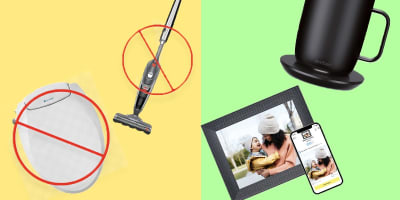We may earn commission from links on this page, but we only recommend products we believe in. Pricing and availability are subject to change.
6 easy hacks — and products! — to save money on your next heating bill
Unfortunately, that’s not a clerical error or a misplaced decimal point on your first energy bill of the season. It’s just really, really expensive to heat a home these days. Don’t get us wrong, there’s a lot to like about winter. Sweater weather! Hot cocoa! Finally having an excuse to light the fireplace that sits dormant for the remainder of the year! But there’s also a lot to loathe about the arrival of the coldest, darkest months of the year. Namely, the deafening sound of dollar signs racking up as soon as you dare to crank up the thermostat.
Door Draft Stopper (36 inches)
ecobee New Smart Thermostat Premium
Easy-To-Cut Weatherstripping Seal For Doors And Windows
Universal Garage Door Bottom Threshold Seal Strip
Costway Electric Portable Laundry Dryer Rack
Cellular Honeycomb Cordless Shades
Globally, it’s more expensive than ever to heat our homes, even though energy efficiency standards have been rising. Even before Russia’s invasion of Ukraine sent energy prices across much of Europe and the rest of the world soaring, many consumers around the globe were already living with crippling inflation on basically everything else.
It’s no wonder why many of us are feeling the pressure to try and lower our heating bills with the tips and tricks we’ve heard a thousand times, like lowering the temperature of your thermostat by a few degrees and heating only the rooms you’re using.
But many experts agree that there are less obvious ways — both big and small — to cut back and save money on your heating and energy bills this winter. Keep reading for their tips and advice that could keep more cash in your pocket this winter.
Save Money This Winter
1. Invest in door draft stoppers to keep the cold air out.
Door draft stoppers are an affordable, low-effort way to block out breezes, noise, light, odors and even bugs.
We’re starting with the low-hanging fruit first, and this one’s about as easy as it gets. Door draft stoppers are an affordable, low-effort way to block out breezes, noise, light, odors and even bugs.
“The quick fix of installing draft stoppers at the bottoms of doors helps prevent chilly air from entering and warm air from escaping,” said George Matusyan, Owner and Operational Manager of United Windows Pro in Colorado.
Most door draft stoppers are designed to look plush like a pillow but are filled with some mix of non-breathable polyester and weighted beads to keep it in place, though you can also find door seals that adhere to the bottom of your door's threshold. You can find them in various lengths, though most are around 36 inches long — the average width of an American doorway. You can also find them in longer lengths, around 72 inches or so, for specialized doorways like sliding glass doors and French double doors.
Perhaps the best thing about weighted door draft stoppers is that they’re portable and temporary. Simply move it where you need it, or pack it away during the off-seasons when you don’t.
2. Enter into the digital age with a smart thermostat.
This one small device claims to save you up to 26% per year on your heating and cooling costs.
Most of our experts agreed that smart and programmable thermostats are one of the simplest ways you can keep more cash in your pocket this winter. “Smart thermostats utilize powerful algorithms that can optimize your home’s heating and cooling, resulting in lower energy bills,” said Thomas Borcherding, Lead Designer and Owner of Homestar Design Remodel in Missouri.
In fact, lowering the daytime temperature in your house by a few degrees can pay off big time. "The best thermostat setting for energy efficiency is 68-degrees during the daytime when you are home; 62-degrees when you are away and 65-degrees while you are sleeping," according to Kelly Bedrich, CEO and Co-Founder of NaturalGasPlans.com. "To get your family acclimated to the temperature setting, make adjustments a degree at a time, over a few days. They won't notice the change as much!"
Products like the Ecobee Smart Thermostat, Google Nest Smart Thermostat and Amazon Smart Thermostat are well-reviewed options that fit most homeowners' needs and allow you to program your preferred temperatures throughout the day. The Ecobee Smart Thermostat, for example, works by using a smart sensor that automatically adjusts the temperature in your most important rooms to reduce hot or cold spots to ensure you're comfortable. It also fills the function of many smart home devices as it includes a built-in air quality monitor, smoke detector and security alerts. It’s compatible with Google and Alexa, and the thermostat’s speaker can be used to listen to your favorite music or podcasts, too. Basically, this one small device claims to save you up to 26% per year on your heating and cooling costs.
Other smart thermometers will have different features, but their core functions remain the same. “They adjust according to daily routines and respond to external conditions,” Matusyan said.
3. Take care to weatherstrip your doors and windows.
What type of weatherstripping you should use depends on your style of doors and windows, and your specific needs.
Weatherstripping is the process of sealing openings around windows and doors to prevent moisture and air from leaking in. “Weatherstripping proves to be an affordable yet potent barrier against drafts, adeptly ensuring warm air remains within while keeping cold out,” said George Matusyan, Owner and Operational Manager of United Windows Pro in Colorado.
Most weatherstripping can be found as strips of foam, felt or vinyl material that you adhere to your doors and windows to reduce leaks, but you can find other varieties of weatherstripping such as metal weatherstripping and V Strips. What type of weatherstripping you should use depends on your style of doors and windows, and your specific needs.
4. Replace your garage door’s bottom seal.
Don't forget about your garage door.
If you’re going through the effort to weatherstrip your doors and windows, do all of your doors and windows — including your garage door.
“Many homeowners don’t realize that there is a rubber seal located on the bottom of their garage door,” Borcherding said. “This seal gets worn out over time, and can result in reduced energy efficiency and can even allow pests and insects to enter the home.”
A universal garage door threshold weatherstripping seal can be used to keep water, wind-blown rain, snow and leaves from entering your garage. Most are designed to be cut to accommodate your specific garage door and to help it create a tight seal. Keep in mind that this particular option does not include sealant or adhesive.
5. Stop using your dryer.
You can buy heated drying racks with or without a fitted insulating cover that’s designed to lock in the heat from the rails to help your laundry dry even faster.
Americans love their dryers, but in many parts of the world tumble dryers are a high-cost, energy-sucking appliance that’s been deemed more expensive than essential. Instead, portable clothes drying racks, hanging clothes drying racks and even electrically heated drying racks are more energy-efficient alternatives to a standard tumble dryer.
Heated electric drying racks are a great option for cooler winter months, when aired laundry might take longer to dry than in warm summer months. You can buy heated drying racks with or without a fitted insulating cover that’s designed to lock in the heat from the rails to help your laundry dry even faster. Best of all, these racks cost just pennies an hour to run.
6. Invest in temperature-regulating curtains and blinds.
Cellular shades or “honeycomb blinds'' work because of their unique hexagonal-shaped cells, which trap air between them creating a barrier between the window and the room.
After you’ve weatherstripped your windows and added door stoppers, one last step you can take to banish cold air is to add temperature-regulating window treatments like thermal curtains and cellular blinds.
Thermal curtains are often made of thick, insulating materials that are designed to keep indoor air in and outdoor air out. Thermal curtains are a great energy-saving hack for renters who can’t make long term improvements and upgrades to their windows. Cellular shades or “honeycomb blinds'' work because of their unique hexagonal-shaped cells, which trap air between them, creating a barrier between the window and the room.
In fact, cellular shades are one of the most energy-efficient window treatments you can invest in, according to reporting by the Department of Energy’s Office Of Energy Efficiency and Renewable Energy. That same study showed that cellular shades could save up to 20% on heating energy and up to 15% on total energy from heating and cooling when compared to windows without shades.
None of these suggestions are likely to change your monthly bills alone drastically, but a combination will help you save and every little bit helps.
SOURCES:
George Matusyan, Owner and Operational Manager of United Windows Pro
Thomas Borcherding, Lead Designer and Owner of Homestar Design Remodel
Kelly Bedrich, CEO and Co-Founder of NaturalGasPlans.com
“Interior Cellular Shades Boost Home Energy Performance” report by Department of Energy’s Office Of Energy Efficiency and Renewable Energy














